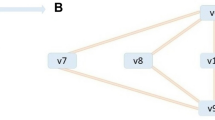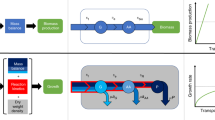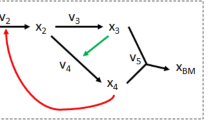Abstract
Recently, there has been an increasing interest in stoichiometric analysis of metabolic flux distributions. Flux balance methods only require information about metabolic reaction stoichiometry, metabolic requirements for growth, and the measurement of a few strain–specific parameters. This information determines the domain of stoichiometrically allowable flux distributions that may be taken to define a strain's “metabolic genotype”. Within this domain a single flux distribution is sought based on assumed behavior, such as maximal growth rates. The optimal flux distributions are calculated using linear optimization and may be taken to represent the strain's “metabolic phenotype” under the particular conditions. This flux balance methodology allows the quantitative interpretation of metabolic physiology, gives an interpretation of experimental data, provides a guide to metabolic engineering, enables optimal medium formulation, and provides a method for bioprocess optimization. This spectrum of applications, and its ease of use, makes the metabolic flux balance model a potentially valuable approach for the design and optimization of bioprocesses.
This is a preview of subscription content, access via your institution
Access options
Subscribe to this journal
Receive 12 print issues and online access
$209.00 per year
only $17.42 per issue
Buy this article
- Purchase on Springer Link
- Instant access to full article PDF
Prices may be subject to local taxes which are calculated during checkout
Similar content being viewed by others
References
Garfinkel, D., Garfinkel, L., Pring, M., Green, S.B. and Chance, B. 1970. Computer applications to biochemical kinetics. Ann. Rev. Biochem. 39: 473–498.
Heinrich, R., Rapoport, S.M. and Rapoport, T.A. 1977. Metabolic regulation and mathematical models. Prog. Biophys. Mol. Biol. 32: 1–82.
Joshi, A. and Palsson, B.O. 1989. Metabolic dynamics in the human red cell. Part I. A comprehensive model. J. Theor. Biol. 141: 515–528.
Kacser, H. and Burns, J.A. 1973. The control of flux. Symp. Soc. Exp. Biol. 27: 65–104.
Reich, J.G. and Sel'kov, E.E. 1981. Energy Metabolism of the Cell. Academic Press, New York.
Savageau, M.A. 1969. Biochemical systems analysis. II. The steady state solutions for an n-pool system using a power-law approximation. J. Theor. Biol. 25: 370–379.
Athel Cornish-Bowden and Maria Luz Cardenas (Eds.). 1990. Control of Metabolic Processes. NATO ASI Series A: Lifesciences Vol. 190. Plenum Press, New York.
Srere, P.A., Jones, M.E. and Matthews, C.K. (Eds.). 1990. Structural and Organizational Aspects of Metabolic Regulation. UCLA Symposia on Molecular and Cellular Biology, New Series, Vol. 133. WileyLiss, New York.
In Neidhardt, F.C. (Ed.). 1987. Escherichia coli and Salmonella typhimurium. Cellular and molecular biology. American Society for Microbiology, Wash., DC.
Varma, A. and Palsson, B.O. 1993. Metabolic capabilities of Escherichia oli: I. Synthesis of biosynthetic precursors and cofactors. J. Theor. Biol. 165: 477–502.
Varma, A., Boesch, B.W. and Palsson, B.O. 1993. Biochemical production capabilities of Escherichia coli. Biotech. Bioeng. 42: 59–73.
Fell, D.A. and Small, J.A. 1986. Fat synthesis in adipose tissue. An examination of stoichiometric constraints. Biochem. J. 238: 781–786.
Savinell, J.M. and Palsson, B.O. 1992. Network analysis of intermediary metabolism using linear optimization: I. Development of mathematical formalism. J. Theor. Biol. 154: 421–454.
Ingraham, J.L., Maaloe, O. and Neidhardt, F.C. 1983. Growth of the Bacterial Cell. Sinauer Associates Inc., Sunderland, Massachusetts.
Neidhardt, F.C. 1987. Chemical composition of Escherichia coli, p. 3–6. In: Escherichia coli and Salmonella typhimurium. Cellular and Molecular Biology. Neidhardt, F.C. (Ed.). American Society for Microbiology, Wash., D.C.
Neidhardt, F.C., Ingraham, J.L. and Schaechter, M. 1990. Physiology of the Bacterial Cell. A Molecular Approach. Sinauer Associates, Sunderland, Massachusetts.
Varma, A. and Palsson, B.O. 1994. Stoichiometric flux balance models quantitatively predict growth and metabolic by-product secretion in wild type Escherichia coli W3110. Appl. and Environ. Microbiol. In press
Varma, A. and Palsson, B.O. 1993. Metabolic capabilities of Escherichia coli: II. Optimal growth patterns. J. Theor. Biol. 165: 503–522.
Murty, K.G. 1983. Linear Programming. John Wiley & Sons, New York.
Varma, A., Boesch, B.W. and Palsson, B.O. 1993. Stoichiometric interpretation of Escherichia coli glucose catabolism under various oxygenation rates. Appl. and Environ. Microbiol. 59: 2465–2473.
Watson, M.R. 1984. Metabolic maps for the Apple II. Biochem. Soc. Trans. 12: 1093–1094.
Watson, M.R. 1986. A discrete model of bacterial metabolism. Computer Applications in the Biosciences. 2: 23–27.
Sonnleitner, B. and Kappeli, O. 1986. Growth of Saccharomyces cerevisae is controlled by its limited respiratory capacity: Formulation and verification of a hypothesis. Biotech. Bioeng. 28: 927–937.
Ko, Y., Bentley, W.E. and Weigand, W.A. 1993. An integrated metabolic modeling approach to desccribe the energy efficiency of Escherichia coli fermentations under oxygen-limited conditions: Cellular energetics, carbon flux, and acetate production. Biotech. Bioeng. 42: 843–853.
Majewski, R.A. and Domach, M.M. 1990. Simple constrained-optimization view of acetate overflow in E. coli. Biotech, and Bioeng. 35: 732–738.
Bajpai, R. 1987. Control of bacterial fermentations. Ann. N. Y. Acad. Sci. 506: 446–458.
Cooney, C.L., Wang, H.Y. and Wang, D.I.C. 1977. Computer-aided material balancing for prediction of fermentation parameters. Biotech. Bioeng. 19: 55–67.
Humphrey, A.E. 1974. Current developments in fermentation. Chemical Engineering 81: 98–112.
Vallino, J.J. and Stephanopoulos, G.N. 1987. Intelligent sensors in biotechnology, applications for the monitoring of fermentations and cellular metabolism. Ann. N. Y. Acad. Sci. 506: 415–430.
Papoutsakis, E.T. 1984. Equations and calculations for fermentations of butyric acid bacteria. Biotech. Bioeng. 26: 174–187.
Papoutsakis, E.T. and Meyer, C.L. 1985. Equations and calculations of product yields and preferred pathways for butanediol and mixed-acid fermentations. Biotech, and Bioeng. 27: 50–66.
Papoutsakis, E.T. and Meyer, C.L. 1985. Fermentation equations for propionic-acid bacteria and production of assorted oxychemicals from various sugars. Biotech, and Bioeng. 27: 67–80.
Tsai, S.P. and Lee, Y.H. Application of metabolic pathway stoichiometry to statistical analysis of bioreactor measurement data. Biotech. Bioeng. 32: 713–715.
Vallino, J.J. and Stephanopoulos, G. 1990. Flux determination in cellular bioreaction networks: Applications to lysine fermentations, p. 205–219. In: Frontiers in Bioprocessing. Bier, M. and Todd, P. (Eds.). CRC Press, Boca Raton, Florida.
Bailey, J.E. 1991. Toward a science of metabolic engineering. Science 252: 1668–1675.
Stephanopoulos, G. and Sinskey, A.J. 1993. Metabolic engineering_methodologies and future prospects. Trends in Biotechnol. 11: 392–396.
Stephanopoulos, G. and Vallino, J.J. 1991. Network rigidity and metabolic engineering in metabolite overproduction. Science 252: 1675–1681.
Vallino, J.J. and Stephanopoulos, G. 1993. Metabolic flux distributions in Corynebacterium glutamicum during growth and lysine overproduction. Biotech. Bioeng. 41: 633–646.
Xie, L. and Wang, D.I.C. 1994. Fed-batch cultivation of animal cells using different medium design concepts and feeding strategies. Biotech. Bioeng. 43: 1175–1189.
Xie, L. and Wang, D.I.C. 1994. Stoichiometric analysis of animal cell growth and its application in medium design. Biotech. Bioeng. 43: 1164–1174.
Goel, A., Ferrance, J., Jeong, J. and Ataai, M.M. 1993. Analysis of metabolic fluxes in batch and continuous cultures of Bacillus subtilis. Biotech. Bioeng. 42: 686–696.
Ferrance, J.P., Goel, A. and Ataai, M.M. 1993. Utilization of glucose and amino acids in insect cell cultures: Quantifying the metabolic flows within the primary pathways and medium development. Biotech. Bioeng. 42: 697–707.
Savinell, J.M. and Palsson, B.O. 1992. Network analysis of intermediary metabolism using linear optimization: II. Interpretation of hybridoma cell metabolism. J. Theor. Biol. 154: 455–473.
Varma, A. and Palsson, B.O. 1994. Predictions for oxygen supply control to enhance population stability of engineered production strains. Biotech. Bioeng. 43: 275–285.
Author information
Authors and Affiliations
Corresponding author
Rights and permissions
About this article
Cite this article
Varma, A., Palsson, B. Metabolic Flux Balancing: Basic Concepts, Scientific and Practical Use. Nat Biotechnol 12, 994–998 (1994). https://doi.org/10.1038/nbt1094-994
Issue Date:
DOI: https://doi.org/10.1038/nbt1094-994
This article is cited by
-
An architecture for collaboration in systems biology at the age of the Metaverse
npj Systems Biology and Applications (2024)
-
Machine learning and metabolic modelling assisted implementation of a novel process analytical technology in cell and gene therapy manufacturing
Scientific Reports (2023)
-
Systematizing Microbial Bioplastic Production for Developing Sustainable Bioeconomy: Metabolic Nexus Modeling, Economic and Environmental Technologies Assessment
Journal of Polymers and the Environment (2023)
-
Network location and clustering of genetic mutations determine chronicity in a stylized model of genetic diseases
Scientific Reports (2022)
-
Modeling energy depletion in rat livers using Nash equilibrium metabolic pathway analysis
Scientific Reports (2022)



